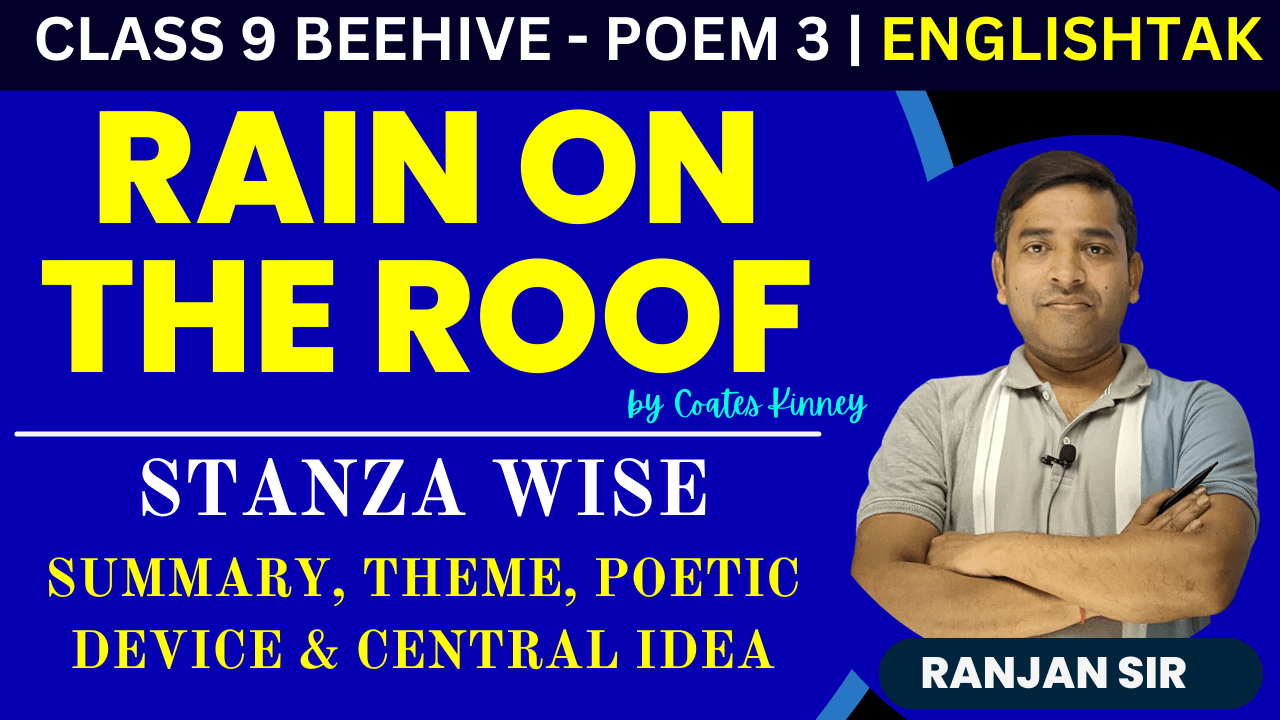![]()
Stanza-wise Summary of “Rain on the Roof”
Stanza-wise Summary of “Rain on the Roof” Introduction: “Rain on the Roof” is a lyrical poem by Coates Kinney that evokes feelings of nostalgia and tranquility through the imagery of rain. Set against the backdrop of a rainy night, the poem explores the emotional connections between the natural world and personal memories. The speaker reflects on the comforting sound of raindrops falling on the roof, which brings back cherished recollections of childhood and maternal love. Through vivid imagery and a soothing tone, Kinney captures the essence of how nature can evoke deep emotional responses and stir the heart with memories of the past. The poem beautifully illustrates the interplay between nature and human emotions, making it a poignant reflection on the power of memories.
Join Our Group
Stanza 1: Stanza-wise Summary of “Rain on the Roof”
The poem opens with a vivid description of a rainy night. The humid shadows cast a gloomy atmosphere over the starry sky, and the darkness seems to weep softly in the form of rain. The speaker expresses the bliss of lying on a soft bed in a cottage and listening to the gentle sound of rain falling on the roof. This sets a comforting and introspective mood, as the rain creates a soothing backdrop.
कविता की शुरुआत एक बारिश भरी रात के जीवंत वर्णन से होती है। जब आर्द्र परछाइयाँ आकाश पर छाई होती हैं और अंधेरा धीरे-धीरे बारिश की बूँदों के रूप में आँसू बहाता है, तब वक्ता अपने घर के बिस्तर पर लेटने का आनंद उठाता है। वह बारिश की नरम आवाज़ को सुनता है जो छत पर गिरती है। यह एक सुखद और चिंतनशील माहौल का निर्माण करता है, जहाँ बारिश एक सुकून देने वाले बैकग्राउंड के रूप में कार्य करती है।
Stanza 2: Stanza-wise Summary of “Rain on the Roof”
In this stanza, the speaker reflects on the emotional impact of the rain’s sound. Each drop creates a tinkle on the roof that resonates within the heart. The sound of the rain stimulates the speaker’s imagination, sparking various dreamy thoughts and memories. It leads to a surge of recollections that intertwine in the mind, symbolizing the powerful connection between nature’s sounds and human emotions. The gentle patter of the rain becomes a catalyst for nostalgia and contemplation.
इस पद में, वक्ता बारिश की आवाज़ के भावनात्मक प्रभाव पर विचार करता है। छत पर हर बूँद की आवाज़ उसके दिल में गूंजती है। बारिश की आवाज़ उसके मन में कई सपने और यादें जागृत करती है, जिससे अतीत की बहुत सी यादें बुनती हैं। यह बारिश की नरम ध्वनि मानव भावनाओं और यादों के बीच गहरे संबंध को दर्शाती है, जिससे सुकून और आत्म चिंतन का अनुभव होता है।
Stanza 3: Stanza-wise Summary of “Rain on the Roof”
The final stanza shifts the focus to a specific memory of the speaker’s mother. He recalls how she used to watch over him and his siblings during their childhood, before leaving them to sleep until dawn. The speaker feels her loving gaze upon him as he listens to the rain. This moment highlights the warmth and comfort associated with maternal love, reinforcing the theme of cherished memories evoked by the sound of rain. The rain not only creates a serene environment but also brings back tender recollections of family and care.
अंतिम पद में वक्ता अपनी माँ की विशेष याद को साझा करता है। उसे याद आता है कि कैसे उसकी माँ उसे और उसके भाई-बहनों को बचपन में देखती थीं, जब वह सोते थे। वह महसूस करता है कि बारिश की आवाज़ सुनते हुए उसकी माँ की प्यार भरी निगाह उस पर है। यह पल मातृत्व के प्यार और गर्माहट को उजागर करता है, यह दिखाते हुए कि बारिश केवल एक प्राकृतिक घटना नहीं है, बल्कि यह परिवार और देखभाल की प्यारी यादों को भी वापस लाती है।
Theme of “Rain on the Roof”
“Rain on the Roof” captures the themes of nostalgia, comfort, and the emotional resonance of nature. The poem illustrates how the simple act of listening to rain can evoke powerful memories and feelings, particularly of childhood and maternal love, making it a deeply reflective piece.
“Rain on the Roof” कविता में nostalgie, सुकून और प्रकृति की भावनात्मक गूंज के विषयों का चित्रण किया गया है। यह कविता दर्शाती है कि कैसे बारिश की सरल ध्वनि शक्तिशाली यादें और भावनाएँ, विशेष रूप से बचपन और मातृ प्रेम की, उत्पन्न कर सकती है, जिससे यह एक गहरी चिंतनशील रचना बन जाती है।
Rain on the Roof Difficult Words Meaning in Hindi
1. Agone: Of times long past, years ago (पहले का समय)
2. Air-threads: Light, delicate strands, often of thought (हवा में उड़ते धागे)
3. Bliss: Deep happiness, serene joy (आनंद)
4. Chamber: Personal room, bedroom (कमरा)
5. Cottage: Small, cozy house, usually in the countryside (कुटिया)
6. Darling: Deeply loved one, cherished person (प्रिय)
7. Dawn: Start of the day, early morning (भोर)
8. Echo: Reflection or resonance of sound (गूँज)
9. Fancies: Whimsical imaginations, daydreams (कल्पनाएँ)
10. Humid: Damp, moisture-filled (गीला)
11. Melancholy: Deep sadness, sorrowful (उदासीपूर्ण)
12. Memory: Past remembrance, recalling the past (स्मृति)
13. Patter: Gentle tapping noise, soft sound of rain (टक – टक का शोर)
14. Pillow: Cushion for resting the head (तकिया)
15. Recollections: Memories, reminiscences (यादें)
16. Refrain: A repeated line in a song or poem (पुनरावृत्ति)
17. Shingles: Wooden tiles on a roof (छत पर लगाई जाने वाली लकड़ी की फट्टियां/स्लेटें)
18. Spheres: Heavenly bodies, celestial orbs (आकाशीय गोलाकार वस्त्र)
19. Starry: Full of stars (तारों से पूर्ण)
20. Tinkle: Soft ringing or jingling sound (मधुर हल्की –सी आवाज़)
21. Woof: Fabric of thoughts or memories (बाना, वस्त्र)
Rain on the Roof Poetic Device
1. Imagery : Vivid and descriptive language that appeals to the senses.
Example: The poem paints a clear picture of a rainy night with phrases like “humid shadows,” “melancholy darkness,” and “patter of the soft rain,” allowing readers to visualize and feel the atmosphere.
2. Personification : Attributing human characteristics to non-human entities.
Example: The rain is described as “gently weeping in rainy tears,” giving it human-like qualities of emotion, which enhances the mood of melancholy and reflection.
3. Alliteration : The repetition of consonant sounds at the beginning of words.
Example: Phrases such as “patters” and “pillow” create a musical quality and enhance the poem’s rhythm, making it more engaging.
4. Assonance : The repetition of vowel sounds within words in close proximity.
Example: The use of similar vowel sounds, as in “bliss” and “press,” contributes to the poem’s lyrical quality and flow.
5. Rhyme Scheme : The pattern of rhymes at the end of each line.
Example: The poem follows a consistent rhyme scheme (ABAB), which adds structure and musicality to the verses.
6. Repetition : The deliberate use of the same word or phrase multiple times for emphasis.
Example: The repetition of “patter” emphasizes the soothing and continuous sound of rain, reinforcing its calming effect on the speaker.
7. Metaphor : A figure of speech that makes a comparison between two unrelated things.
Example: The rain acts as a metaphor for memories and emotions, symbolizing both sadness and comfort.
8. Symbolism : The use of symbols to represent ideas or qualities.
Example: The roof represents safety and comfort, while the rain symbolizes the flow of memories and emotions that come flooding back during quiet moments.
9. Tone : The attitude of the poet towards the subject.
Example: The tone of the poem is reflective and nostalgic, evoking a sense of longing for the past and the comfort of childhood memories.
10. Enjambment : The continuation of a sentence or phrase from one line of verse to the next without a pause.
Example: Many lines flow into the next without punctuation, creating a sense of fluidity and emphasizing the uninterrupted sound of the rain.
CBSE Class 9th English
The Road Not Taken Summary & Analysis
Stanza-Wise Summary of “The Wind”
The Fun They Had Class 9 MCQ Questions
The Fun they Had Questions Answers





